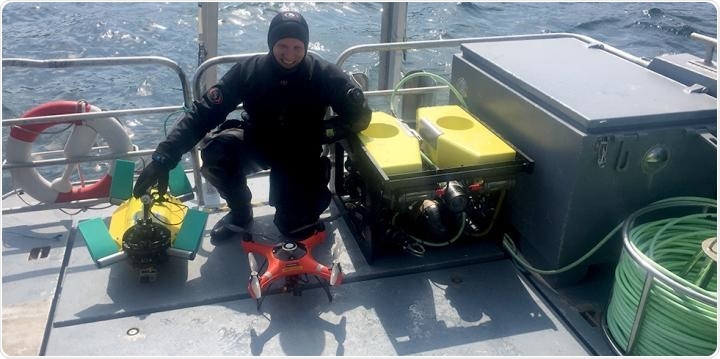Up to 200,000 farmed salmon can be accommodated in a sea cage, but if the cage becomes damaged, for example, if a hole develops in the nets, the fish can swim out via this hole and escape quickly.

A new field of research is looking at the interaction between fish and robots. Results show that the fish are far more affected by their environment than we have been aware of. Image Credit: Maarja Kruusmaa.
Such a scenario would not be preferred by the aquaculture industry. Escapes not only result in huge losses for the industry, but also raise concerns over the mix and interbreeding of farm-raised salmon and wild populations.
Hence, it is important to monitor the activity inside the cages, so that any damage caused to the cages can be repaired quickly.
Tracking life in the sea cages is also significant for other reasons, like ensuring better fish welfare—for example, what is the fish’s health condition? Do the cages require cleaning? How serious is the salmon lice problem?
The conditions in sea cages are usually checked through human divers as well as underwater vehicles managed by operators on land. However, these two types of intruders are likely to disturb and stress the fish. Such techniques further restrict the frequency of assessments.
Biology researchers and robotics have been attempting to find the ideal monitoring techniques that would cause minimal disturbance to fish. The tests, in which a robotic turtle swims around the cage to image the fish and equipment, have been shown to perform the inspection task better and more sensitively.
The experiments demonstrated that the fish are only slightly stressed or frightened by the robotic turtle and they swim calmly and relatively close to the turtle. On the other hand, the fish keep away from the intruders in experiments that involved thruster-driven underwater robots and divers.
The overall purpose of the experiments wasn’t just to test the turtle robot, but also to investigate what characteristics robots being used in the aquaculture industry should have.”
Maarja Kruusmaa, Professor, Department of Engineering Cybernetics, Norwegian University of Science and Technology
Kruusmaa is also a professor at Tallinn University of Technology.
“We’ve found that the most crucial characteristics of the surveillance robot are its size and speed, whereas color and motor noise hardly matter at all,” she added.
The slow movements and small size of the turtle robot are the traits that render it to cause a minimal disturbance to the fish. The fact that the turtle robot resembles a marine organism is less significant.
The conclusion turned out to be the opposite of our expectations. The fact that the robot looks like a marine animal doesn’t seem to play any role at all. And that’s actually good news—it means we don’t have to build the robots to be fish- or turtle-like. That will make it cheaper to develop and use robots in this new field of application to monitor marine organisms.”
Maarja Kruusmaa, Professor, Department of Engineering Cybernetics, Norwegian University of Science and Technology
The study indicates the types of factors that are vital when designing robots for the fish farming sector, or for tracking fish in their natural environment.
Kruusmaa, and Jo Arve Alfredsen—an associate professor in the Department of Engineering Cybernetics at Norwegian University of Science and Technology (NTNU), have published an article about their latest findings the Royal Society Open Science journal. Kruusmaa is the study’s first author.
Both Kruusmaa and Alfredsen are employed by NTNU AMOS—the Centre for Autonomous Marine Operations and Systems. AMOS is designing novel types of underwater vehicles as well as the latest offshore monitoring techniques as their area of focus.
Fish breeders can benefit from robots like the robotic turtle that provide online updates and help track life inside the sea cage. The robotic turtle can also be connected to various sensors and measuring instruments.
Utilizing such robotic technology rather than divers for surveillance purposes enables uninterrupted and continuous monitoring. This continuity can considerably contribute to faster responses, better fish welfare, greater predictability, and lower mortality.
The scientists performed the practical experiments in full-scale aquaculture laboratory, ACE of SINTEF Ocean. The laboratory is managed by SalMar as part of the EU project—AQUAEXCEL2020. NTNU, SINTEF, and Tallinn University of Technology are working together on this project.
Named U-CAT, the robotic turtle was designed at Tallinn University of Technology in Estonia and was originally developed for underwater archaeology applications. The aim was to use the robotic turtle to inspect shipwrecks on the seafloor, and hence it was developed as a compact and highly maneuverable robot.
Alfredsen found that the robot could be utilized in aquaculture because it had exactly the same properties. The experiments performed in the sea cages at SalMar have demonstrated that the aquaculture industry can also benefit from this robotic technology.
Source:
Journal reference:
Kruusmaa, M., et al. (2020) Salmon behavioural response to robots in an aquaculture sea cage. Royal Society Open Science. doi.org/10.1098/rsos.191220.